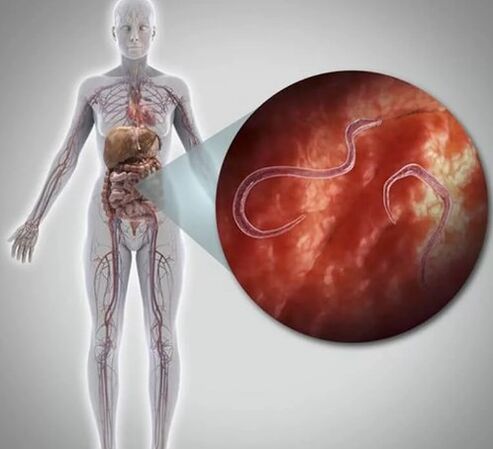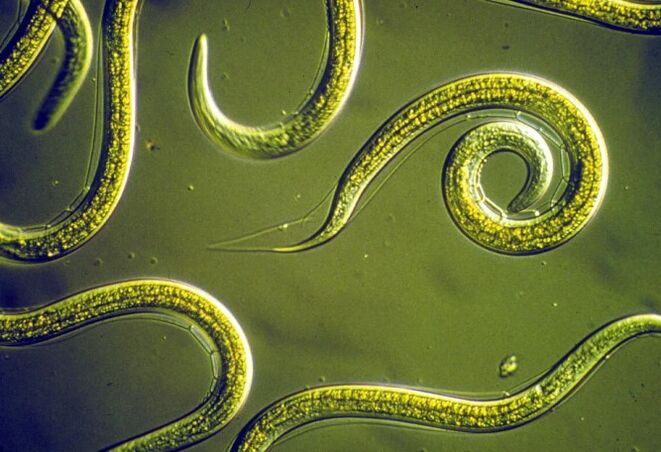Human parasites are parasites whose infection is exposed to a person. The general definition of the word "parasitic" is not only for multicellular and protozoa, to the detriment of their owner and to the detriment of the latter, but also to similar properties of viruses, bacteria and fungi. According to historical tradition and from the point of view of medical parasitology, it is customary to call every parasitic lifestyle, except viruses and bacteria with similar qualities.
The parasites include many helmin, mushrooms, viruses, protozoa, worms, crustaceans, spider shaped, insects. Parasites owners can be bacteria, simplest, plants, animals and humans. Parasites go through a complex development cycle: sometimes they need to change 2-3 owners, whose body is intermediate (Helmin passes through the larva) or the final (the helmints become invasive).
From history:
Studying the parasites of ancient people is based on the study of stools and other petrified materials. The earliest parasites found in man were the paragonimus Westerman eggs from the northern Chile, discovered in the hardened stool, and approx. 5900 dated. e. In Brazil, hooks from E. 5000 BC were also found. e. , In Peru -Gender eggs from E. 2330 BC. e. And the Egyptian mummies that go back to 2000, 1250 and 1000 years. I. E. e. They contained the Sololiter egg and a well -fertilized female worm.
In Berlin, for the period 1866-1875. 16% of all open corpses contained worms. The Taeniarhynchus saginatus is particularly widespread, where raw cattle were consumed. According to Kessler, in St. Petersburg, 3, 66 % of the persons under investigation suffered from this parasite (1888). Pig tensia (Taenia solium) can be found everywhere in areas where they eat raw or semi -pork. In St. Petersburg at the end of the 19th century, the population was approx. 3 % suffered from this parasite. When the use of raw meat began to be avoided, the percentage of diseases decreased extremely, for example in Denmark from 53 % to 20 % for 10-12 years. Dypilidium caninum lives in dogs and cats and rarely in the bowel of children. At the end of the 19th century, cases of children's infection were known from England, Germany and Denmark: infection only when fleas swallowed.
Parasites and their discharge(Products of their lives) The strongest venues in the human body. They cause severe acidification and thickening of blood and entire internal environment. They provoke the most serious health disorders. From bronchitis to oncology. Destroy the man's psyche, deprive him of peace and sleep. In the child's body, parasites prevent normal development of the child's nervous system and contribute to a mental and physical disadvantage in long -current disease.
Classification
With distribution:
- All Biquette - meet you everywhere.
- Distributed in tropical - tropical climate zones.
About biological and epidemiological features:
- Geohelminths is a disease in which helmints are developed more often in the human body and then in the non -Living substrate, on earth.
- Biohelminths is a disease in which the biological cycle of helmin development should take place in the body of other organisms, except for a person. A distinction should be made between the final owners, the body of the helmink into the sexually mature stage, and the intermediate where the parasite is in the larva stage or its reproduction is not sexually. A person is more often the final owner, less often - intermediate.
- Contact helminthiasis is a disease in which parasites are distinguished from the mature or almost mature of the human body, which results in another person infection or re -infection (automatic invasion, re -invasion).
Depending on the localization of the parasite:
- Enlightenment - lives in the cavity of a person's intestine and other cavities (such as ascarides, ligaments).
- Tissue lives in tissue (sistematis, ehinokokk).
At the owner's location:
- External: Mosquitoes, blind, leeches, lice.
- Internal(Helminthias):Round worms(Nematodes - Ascarids, Filaraia, Vlasov, Pinworms, Strunggyloids, Ancylostomidae, Trichinella);Flat worms:
- Trematodes (Sazealjak - cat bikelter (opisthorchis), Klóner, fasciola, Schistosomes);
- Cestodes (ribbons - bulls and pork, dwarf tanning, wide ribbon, echinococcus).
- Bacteriosis(Leptospira, Staphylococcus, Streptococcus, Shigella).
- Protus(Amoebas, Giardia, Trichomonas, often owners of Chlamydia and AIDS virus).
- Mycoses(Fungal Diseases) - Candida, Cryptococcus, Penicillium.

How do parasites enter the body?
Parasitism can not only be infected with dirty hands. Animal hair is a carrier of worms (ascaride and toxocara), Lamblia. Pinworms eggs dropped from wool are viable for up to 6 months and fall into the food stroke through dust, toys, rugs, lingerie and bedding and hands. A dog disperses eggs through wet breathing 5 meters (cat - up to 3 meters). Dogs fleas also tolerate worm eggs. Askarid eggs enter the body with poorly washed vegetables, fruits, berries, greens, dirty hands and flies. And incorrectly cooked barbecue or homemade tape is the path of infection with trichinellosis; Poorly salted fish, caviar - opisthorchiasis and wide ribbon.
So there are many ways to enter the body:
- habitat (infected foods, water, dirty hands);
- Relationships (household items, from infected family members, pets);
- Transmission (through blood -sucking insects);
- Percutaneously or active (in which the larva penetrates the skin or mucous membranes during contact with the infected soil when bathed in open containers).
Symptoms of parasites
It is not at all necessary for the infection to somehow manifest at all. Occasionally one feels healthy, despite the invasion, due to strong immunity. Individual time will be healthy. Then, according to the extinction of immunity (demolition can occur at any time, stress, surgery, illness) - the quiet signs of the parasite will continue to serve. It is a urine with odor, acne on the skin, stubborn cough with clean lungs, unstable stools, pungent odor or constipation, gas formation, unpleasant odor from the mouth. Bruxism is the most specific manifestation of the presence of helmintek (nighttime rattles of the teeth). Night saliva, the usual nausea, the perversion of night hunger, tireless hunger, sweet and acidic food addiction, and breathing. Children's appetite or election appetite are reduced. Occasionally, people with increased appetite are found, but at the same time they lose weight.
General signs of parasite invasions
Constipation, stagnation of bile

Because of their shapes and large size, some worms can mechanically close the intestinal lumen, the bile duct wires, which leads to the deterioration of the peristaltis, the formation of constipation, and the entire or partial bowel obstruction. The Hlybon invasion can provoke the obstruction of the ordinary bile duct, which causes difficulties in the outflow of bile, mechanical jaundice.
Diarrhea
Many parasites, especially protozoal, produces substances similar to prostaglandins leading to sodium and chlorides, which in turn provoke diarrhea - frequent water intestinal movements.
Gastric and bowel discomfort syndrome
Parasites living in the upper intestine cause inflammation and lead to interruption of the intestine, bloating. This leads to a reduction in nutrient absorption. As a result, the small intestine fats fall into the colon, provoking cramps, alternating constipation and diarrhea.
Joint pain and muscles
Parasites can move around the human body to settle in the most comfortable places, such as joint fluid and muscles. Tissue inflammation is a result of injury to parasites or the result of the body's immune response to their presence. At the same time, a person experiences muscle and joint pain.
Allergy
Parasites can interfere with the normal permeability of the intestinal mucosa, which increases the risk of penetrating large, non -digested food particles. This activates the body's immune response - the level of eosinophils - is the protective blood cells of our body, which contributes to the development of allergic reactions. Parasites cause increased production on this body of immunoglobulin, which improves allergic reactions.
Problem skin
The intestinal parasites can cause allergic skin reactions - atopic dermatitis, urticaria, eczema. Most often, inflammatory changes in the skin can be the consequences of protozoa microorganisms (lamblia, fungus) and the presence of opisthorchis.
Body mass is changing
Weight fluctuations (both normal and less) can be the result of parasitic disease. Weight loss is due to the fact that digestion in the body is deteriorating because there is an "internal consumer". Obesity is also the result of the "robbery" of the human body, with the Helmintes invasion. The feeling of hunger occurs with a sharp decrease in blood glucose due to the activity of helmintek and toxic effects of the body.
Anemia
The intestinal wall is connected to many types of intestinal news, damage that causes a rather greater blood loss, leading to anemia.
Nervousness, sleep disruption
Toxic materials for vital activity of parasites irritate the central nervous system, causing increased anxiety and nervousness. In the middle of the night, frequent awakening, especially between 2 and 3 hours, is also the result of body experiments to get rid of toxic substances through the liver.
"Chronic fatigue syndrome"
"Chronic fatigue syndrome" includes weakness, impossible decrease and fever, emotional instability, loss of concentration and poor memory. These symptoms may be the result of anemia, intoxication, and the lack of nutrients caused by parasites in the body.
After discovering his family members in several symptoms, he is involved in parasitism through diagnostics and performs preventive treatment.

Diagnosis
Recently, the presence of parasites has only been determined by microscopic tests by a method of duodenal and stool testing, which aims to detect selected helmits or fragments, eggs and larvae. The eggs and larvae of the helmints are found in the liver, in the bile roads, the pancreas and the duodenum larvae in bile and duodenal content; The stool samples were examined in the shapes of helminthias; In the case of suspected paragonimozes, sputum and urine urine were tested by gangiturinary chistosomosis. But the reliability of these studies depends on the professionalism of the workers - the laboratory assistant notices in the microscopic examination of parasites. In addition, if the parasite did not postpone the eggs the moment when the check was executed, its presence will be unnoticed by highly qualifying the laboratory assistant. Often, only 8-10 experiments can get positive results.
Nowadays, there are immunological studies that allow the presence of antigens in the blood of the infected person and the presence of antibodies against various parasites. The reliability of such analyzes depends on the life cycle and amount of parasites in the body.
Children are the most vulnerable to the effects of parasites. They are infected with different types of parasites through dirty hands, sand, soil and water. Occasionally, child infection can occur in intrauterine, as the simplest bacteria, viruses, candida and helmin larvae can penetrate the fetus through placenta, blood flow and birth channel.
Do not risk the health of your children, do preventive decorative courses.






































